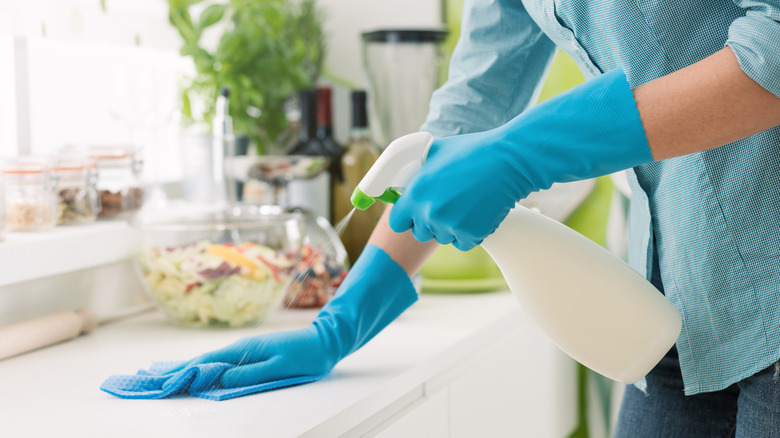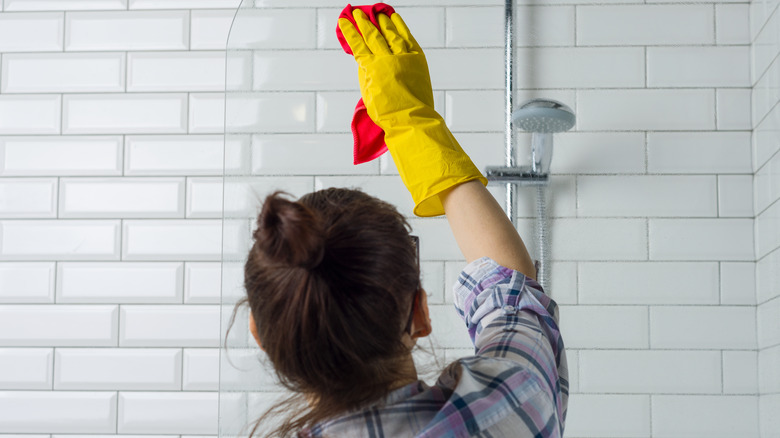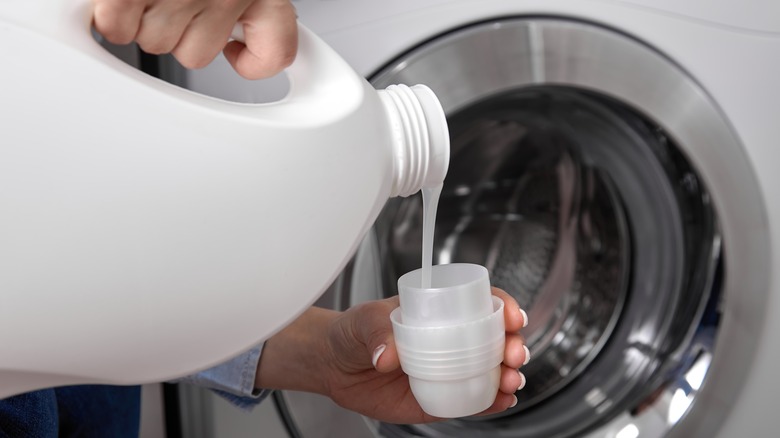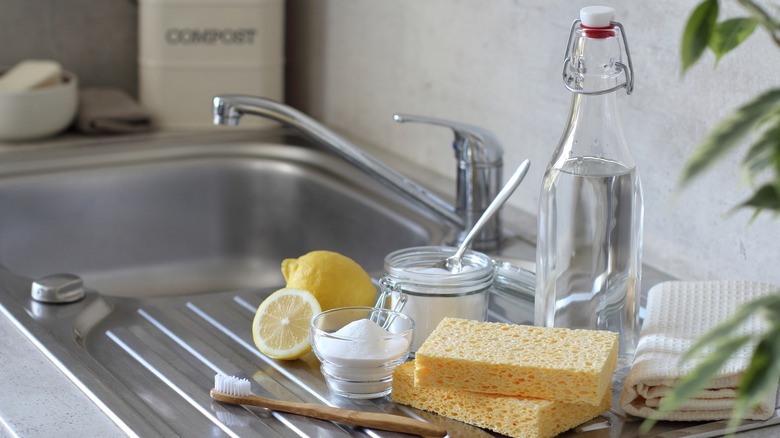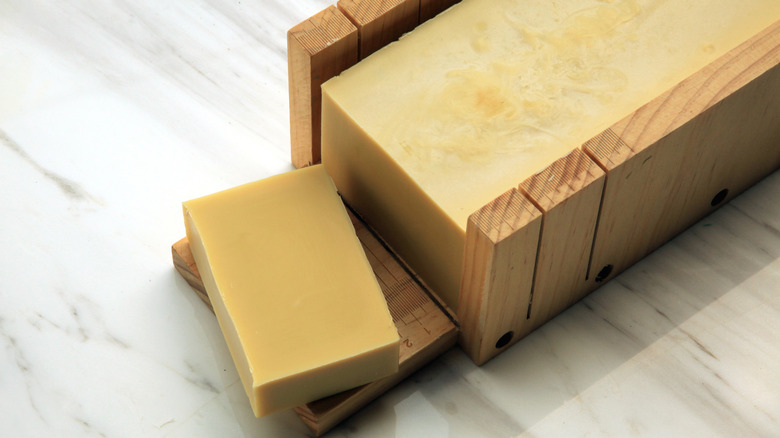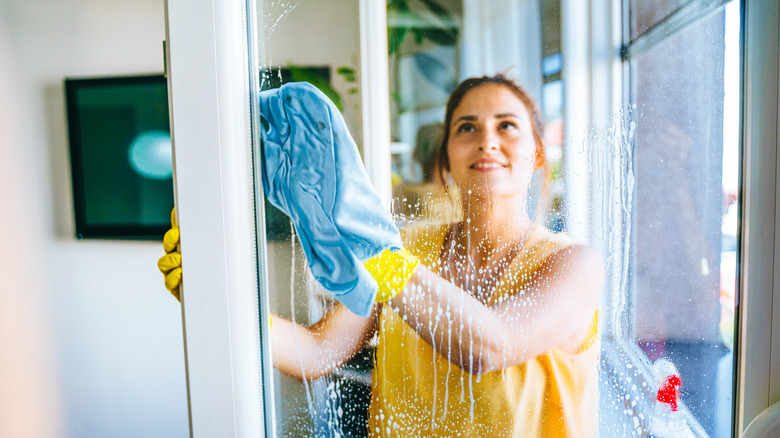Common Cleaning Products That Shouldn't Be Mixed With Vinegar
Not just for adding that little something extra to a dish, vinegar can be an excellent tool to have in your cleaning cupboard. However, one of the biggest mistakes you could be making when cleaning with vinegar is mixing it with cleaning products it really shouldn't be mixed with. Just as there are certain areas you should never clean with vinegar, vinegar can become ineffective at best and potentially dangerous at worst when combined with other ingredients.
Don't pose a risk to yourself by thinking vinegar is okay to use with everything. Vinegar may be natural compared to commercially-produced cleaning sprays, but this doesn't mean it's safe to use with all products. The main products you should steer clear of when cleaning with vinegar are bleach, ammonia, hydrogen peroxide, castile soap, and baking soda. While these ingredients are all good for cleaning individually, they won't create the best outcome for you or your home when mixed with vinegar.
Vinegar and bleach
When you're cleaning your home, always avoid mixing vinegar with bleach. This lethal combination will create chlorine gas,which can cause problems with your breathing and even respiratory distress if inhaled in high enough quantities, an outcome David A. Walla, PhD, lead scientist for liquid detergent Defunkify, backs up. Walla told Real Simple that mixing "bleach and vinegar—or any acid or acidic product, such as toilet cleaner—[creates] chlorine gas. This can lead to coughing, breathing problems, burning, and watery eyes."
A lot of cleaners, especially if they are formulated for a bathroom or made to remove stains from laundry, contain bleach. Vinegar should not be mixed with these products, either. If you do accidentally make chlorine gas, leave the affected area as soon as possible and don't return until you feel recovered. To avoid this situation in the first place, drop the bathroom cleaner and create a one-part water and one-part vinegar combo. This mix can be used on any area of your bathroom to leave it clean and shiny. To remove stains from your clothes, mix one tablespoon of vinegar and one tablespoon of detergent and apply the mix to your clothes before leaving it for an hour. Wash as usual.
Vinegar and hydrogen peroxide
Another mix you should stay away from is vinegar with hydrogen peroxide. Much like how combining bleach with vinegar makes chlorine gas, vinegar and hydrogen peroxide together will make a substance called peracetic acid. Per Southern Living, cleaning expert Armeka Townsend explained, "Peracetic acid can cause respiratory and eye irritation, as well as skin burns and damage to the lungs in higher concentrations." It can also cause damage to what it's used on, so it isn't good for you or your furniture.
Hydrogen peroxide is often used when doing laundry, and can be very effective at removing stains and brightening clothes by itself without any extra ingredients. Simply throw a cup into your laundry before you add in your clothes or towels and put a cycle on as usual. Make sure you use the 3% kind and don't add anything other than the hydrogen peroxide to your machine (for example, bleach) to prevent any ill effects.
Vinegar and baking soda
Vinegar and baking soda both often rank high on the list of chemical-free cleaning agents. Moreover, unlike other ingredients on this list, you'll be pleased to hear that pairing vinegar and baking soda together isn't a dangerous thing to do. The bad news is that it is an essentially useless combination. Speaking to The Spruce, Mary Gagliardi, in-house scientist for Clorox, revealed, "Vinegar and baking soda aren't dangerous when combined, but they aren't very effective either. When mixed together, vinegar and baking soda neutralize each other and lose their cleaning properties."
Don't bother wasting ingredients and time making a cleaning solution that won't really do anything. If you do want to use both items, wait until one has been cleaned before you use the other to prevent the neutralization effect mentioned by Gagliardi. For example, putting vinegar in your toilet will help disinfect it and get rid of stains. Pour a cup of vinegar into the bowl, covering it evenly, and then leave it to set for at least a few hours but preferably overnight before flushing it away. Where baking soda is effective is the toilet tank. Add a cup of baking soda to your tank (the water supply should be switched off) and leave it for half an hour. Clean the inside with a brush thoroughly and then re-start the water supply, let it fill, and then flush.
Vinegar and castile soap
Castile soap (a soap made with olive oil and sodium hydroxide) and vinegar can be great ingredients to clean with separately, but together this combination loses a lot of its cleaning power. It isn't harmful to your health or your furniture, but it is one to steer clear of the next time you're experimenting with making homemade cleaning products. This is because the acid found in vinegar will not work well with the texture of castile soap, leaving you with a gross and oily residue instead of something you would want to use for cleaning.
We don't recommend using them together, but these two ingredients can be used one after the other to ensure your countertops are left clean and shiny. However, castile soap will sometimes leave a film behind on harder surfaces. To get rid of this film, once all remaining soap has been removed, mix one cup of vinegar into a quart of water and use the solution to wipe away any residue.
Vinegar and ammonia
You might know that ammonia should never be mixed with bleach, but it shouldn't be mixed with vinegar, either. Not only does mixing these two ingredients make for a high-pH solution that could cause some major damage, but cleaning expert Rocky Vuong told Apartment Therapy that it can create "an unpleasant odor." Additionally, an important thing to remember is that products like glass cleaner usually contain ammonia. Always check the label to ensure you don't mix vinegar with any glass cleaner products (unless they are free of ammonia).
Per Global News, Andrew Gayman, director of Charles Macpherson Academy, said, "Never mix vinegar with other cleaning products like bleach or ammonia or those 'blue' window cleaning products (for example, Windex), because they can create dangerous chlorine gas." As mentioned above, chlorine gas can cause eye irritation and a sore throat even in low levels. However, sometimes vinegar doesn't leave the finish you want and you need window cleaner to finish the job. To keep yourself safe, only go in with vinegar once you have wiped all traces of glass cleaner from your window.
